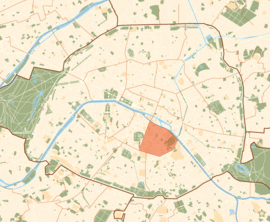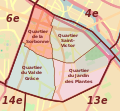world.wikisort.org - France
The 5th arrondissement of Paris (Ve arrondissement) is one of the 20 arrondissements of the capital city of France. In spoken French, this arrondissement is referred to as le cinquième.
5th arrondissement of Paris | |
|---|---|
Municipal arrondissement | |
 A view of Rue Soufflot from the west with the Panthéon in the background | |
 Coat of arms | |
 Location within Paris | |
| Coordinates: 48°50′50″N 2°20′40″E | |
| Country | France |
| Region | Île-de-France |
| Department | Paris |
| Commune | Paris |
| Government | |
| • Mayor (2020–2026) | Florence Berthout (SL) |
| Area | 2.54 km2 (0.98 sq mi) |
| Population | 58,227 |
| • Density | 22,924/km2 (59,370/sq mi) |
| INSEE code | 75105 |
 20 arrondissements of Paris | |||||||||||||||||||||||||||||||||||||
|---|---|---|---|---|---|---|---|---|---|---|---|---|---|---|---|---|---|---|---|---|---|---|---|---|---|---|---|---|---|---|---|---|---|---|---|---|---|
|
|||||||||||||||||||||||||||||||||||||
The arrondissement, also known as Panthéon, is situated on the Rive Gauche of the River Seine. It is one of the capital's central arrondissements. The arrondissement is notable for being the location of the Quartier Latin, a district dominated by universities, colleges and prestigious high schools since the 12th century when the University of Paris was created.[2] It is also home to the National Museum of Natural History and Jardin des plantes in its eastern part.
The 5th arrondissement is also one of the oldest districts of the city, dating back to ancient times. Traces of the area's past survive in such sites as the Arènes de Lutèce, a Roman amphitheatre, as well as the Thermes de Cluny, a Roman thermae.
Geography
The 5th arrondissement covers some 2.541 km² (0.981 sq. miles, or 628 acres) in central Paris.
Demography
The population of the arrondissement peaked in 1911 when the population density reached almost 50,000 inhabitants per km². In 2009, the population was 61,531, while 48,909 worked in the arrondissement.
Historical population
| Year (of French censuses) |
Population | Density (inh. per km²) |
|---|---|---|
| 1872 | 96,689 | 38,052 |
| 1911 (peak of population) | 121,378 | 47,768 |
| 1954 | 106,443 | 41,890 |
| 1962 | 96,031 | 37,793 |
| 1968 | 83,721 | 32,948 |
| 1975 | 67,668 | 26,630 |
| 1982 | 62,173 | 24,468 |
| 1990 | 61,222 | 24,094 |
| 1999 | 58,849 | 23,160 |
| 2009 | 61,531 | 24,225 |
Immigration
| Born in metropolitan France | Born outside metropolitan France | |||
|---|---|---|---|---|
| 80.0% | 20.0% | |||
| Born in overseas France |
Born in foreign countries with French citizenship at birth1 | EU-15 immigrants2 | Non-EU-15 immigrants | |
| 0.8% | 4.5% | 5.4% | 9.3% | |
| 1 This group is made up largely of former French settlers, such as Pieds-Noirs in Northwest Africa, followed by former colonial citizens who had French citizenship at birth (such as was often the case for the native elite in French colonies), as well as to a lesser extent foreign-born children of French expatriates. Note that a foreign country is understood as a country not part of France in 1999, so a person born for example in 1950 in Algeria, when Algeria was an integral part of France, is nonetheless listed as a person born in a foreign country in French statistics. 2 An immigrant is a person born in a foreign country not having French citizenship at birth. Note that an immigrant may have acquired French citizenship since moving to France, but is still considered an immigrant in French statistics. On the other hand, persons born in France with foreign citizenship (the children of immigrants) are not listed as immigrants. | ||||
History
This section does not cite any sources. (May 2011) |
The Ve arrondissement is the oldest arrondissement in Paris, and was first built by the Romans.
The construction of the Roman town Lutetia dates back from the 1st century BC, which was built after the conquest of the Gaulish site, situated on the île de la Cité by the Romans.
Saint-Hilaire is a ruined 12th-century church in Paris, active until the French Revolution.
Government and infrastructure
The Ministry of Higher Education and Research has its head office in the arrondissement.[3]
Previously the Bureau d'Enquêtes sur les Événements de Mer (BEAmer) had its head office in the 5th arrondissement.[4]
Economy
This section may lend undue weight to certain ideas, incidents, or controversies. (January 2021) |
Sony Computer Science Laboratories (ソニーコンピュータサイエンス研究所) Paris is in the arrondissement.[5]
Maps
 Map of the 5th arrondissement
Map of the 5th arrondissement The 5th arrondissement in Open Street Map
The 5th arrondissement in Open Street Map Neighborhoods of the 5th arrondissement
Neighborhoods of the 5th arrondissement Metro map of the 5th arrondissement
Metro map of the 5th arrondissement
Cityscape


Places of interest
- Arènes de Lutèce
- Bibliothèque Sainte-Geneviève
- Centre de la Mer et des Eaux
- Fontaine Saint-Michel
- Institut du Monde Arabe (Arab World Institute)
- Jardin des Plantes and the Musée National d'Histoire Naturelle
- Maison de la Mutualité
- Montagne Sainte-Geneviève
- Musée de Cluny, hosting the Thermes de Cluny
- Musée de l'Assistance Publique - Hôpitaux de Paris
- Musée Curie
- Musée des Collections Historiques de la Préfecture de Police
- Musée de la Sculpture en Plein Air
- The Panthéon
- Quartier Latin
- Val-de-Grâce military hospital
Religious buildings
- Church of Val de Grâce
- Saint-Ephrem church
- Notre-Dame-du-Liban church
- Saint-Étienne-du-Mont church
- Saint-Jacques-du-Haut-Pas church
- Saint-Jean-l'Evangéliste church
- Saint-Julien-le-Pauvre church
- Saint-Medard, Paris church
- Saint-Nicolas-du-Chardonnet church
- Saint-Séverin church
- La Grande Mosquée (Great Mosque of Paris), created in 1922 after World War I, as a sign of recognition from the nation to the fallen Muslim tirailleurs who lost their lives at Verdun (and in the take-back of Douaumont fort)
Colleges and universities
As part of the Latin Quarter, the 5th arrondissement is known for its high concentration of educational and research establishments.
- Collège de France
- Collège international de philosophie
- École Polytechnique (historical campus; the school has now been relocated)
- PSL University
- École Normale Supérieure
- ENSCP - Chimie Paris
- ESPCI Paris
- Sorbonne University - Faculté des sciences
- Jussieu Campus
- Université Paris Cité
- Faculté de médecine de Paris Centre
- Institut de Physique du Globe de Paris
- Sorbonne
- Sorbonne University - Faculté des Lettres
- University of Paris I Panthéon-Sorbonne
- University of Paris III Sorbonne Nouvelle
- Rectorate of Paris
- Famous lycées with preparatory classes to the Grandes écoles
- Lycée Louis-le-Grand
- Lycée Henri IV
Main streets and squares
|
|
References
- "Populations légales 2019". The National Institute of Statistics and Economic Studies. 29 December 2021.
- "Map of Paris arrondissements". Paris Digest. 2018. Retrieved 2018-11-21.
- "Mentions légales - Crédits." Ministry of Higher Education and Research. Retrieved on 6 May 2011. "Ministère de l'enseignement supérieur et de la recherche DELCOM - Département de la communication (DEPCOM) (organigramme) Adresse : 1, rue Descartes - 75231 Paris Cedex 05"
- "Contact Us." Bureau d'Enquêtes sur les Événements de Mer. December 23, 2003. Retrieved on June 22, 2017. "Mail address : BEAmer 22, rue Monge 75 005 PARIS"
- "Contact Archived 2017-12-13 at the Wayback Machine." Sony Computer Science Laboratories Paris. November 16, 2017. "6, rue Amyot, 75005 Paris, France"
External links
 5th arrondissement travel guide from Wikivoyage
5th arrondissement travel guide from Wikivoyage
На других языках
[de] 5. Arrondissement (Paris)
Das 5. Pariser Arrondissement, das Arrondissement du Panthéon, ist das älteste der 20 Pariser Arrondissements. Es geht auf das in der römischen Antike errichtete Lutetia zurück und bedeckt den größten Teil des Quartier Latin, des traditionellen Universitätsviertels.- [en] 5th arrondissement of Paris
Другой контент может иметь иную лицензию. Перед использованием материалов сайта WikiSort.org внимательно изучите правила лицензирования конкретных элементов наполнения сайта.
WikiSort.org - проект по пересортировке и дополнению контента Википедии



